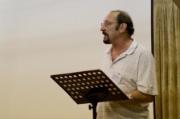
Since South Africa emerged from cultural isolation, the challenges of a globalised jazz industry has led to live performance becoming the dominant means of expression.
Black jazz artists express performance confidence in ways very different to their fellows who were performing under the harsh apartheid laws, says Professor David Coplan of Wits University.
Professor Coplan, was one of the acclaimed national and international jazz academics who participated in the jazz symposium held recently at Rhodes University.
According to Prof Coplan, the return of exiles such as Abdullah Ibrahim after the collapse of apartheid revitalised South African jazz, although it did not necessarily fit with the emerging black nouveau riche. Rather it was the older, more modest black middle class which can be credited with jazz’s revival.
At the same time, a new and multiracial generation of university students were being encouraged to appreciate jazz, and de-segregated venues sprang up, where jazz and associated music forms were played. Despite some opposition from jazz purists, and residual resistance to jazz fusion persisting in some quarters, the last decade and a half has seen a flowering of fusion styles, such as afro-pop, isiXhosa-jazz, afro-rave, kwaito and others.
On the other hand, digital media has made it possible for primary music makers to work with smaller studios to market and issue their product. While South African music has for centuries been hybrid and cosmopolitan, says Prof Coplan, the digital revolution has given performers more access to indigenous, new world and global forms to make their own.
For Brett Pyper, who is currently working on his PhD through New York University, which examines the ways in which listening, no less than musical performance itself, is socially enacted. The talks about the “symbolic mobility of what we call jazz” which sees South African jazz drawing strongly on the afro-diasporic movement of black Africans.
The stokvel (in essence a music appreciation club or society), has remained a relatively under-documented aspect of the jazz scene in post-apartheid South Africa. This distinct culture of appreciative listening allows the emphasis to be shifted to the listeners, and allows an understanding of the contemporary meaning of jazz to emerge.
As South Africa is a still divided society, particularly in the socio-economic sphere, Pyper asks in his paper on “Jazz, sociability and inequality in South Africa – perspectives from the contemporary stokvel scene,” if jazz can act as a signifier of mobility within the post-apartheid landscape.
Perhaps, he suggests, jazz can be resurrected as a form of activism, a way of connecting people and bringing them together.
Rhodes Jazz Studies Lecturer, Dr Nishlyn Ramanna discussed jazz as capital, looking at contemporary jazz and meta-narratives of nation in post-apartheid South Africa.
He explains that music is a valuable resource which has the capacity to shape both individual and social perceptions of the environments in which it is heard. In this way it functions as a form of capital, accruing value exchange value.
In post-apartheid South Africa, the middle and business classes became, according to Dr Ramanna, enamoured of jazz as a medium which spoke to both their African-ness and their emerging economic power.
This facilitated their investment in the script underlying the government-driven concepts of the Rainbow Nation and African Renaissance. Jazz’s status as capital is underwritten by these scripts, he says.
Dr Ramanna warned that academics needed to interrogate the power structures which underlie South African jazz to avoid the label of ‘shoe-shine boys’ to the political elite.
By Jeannie McKeown
Photo: Professor David Coplan
Photo by Adrian Frost
